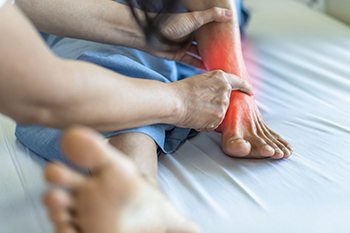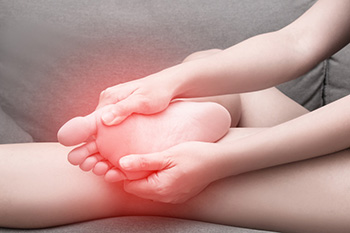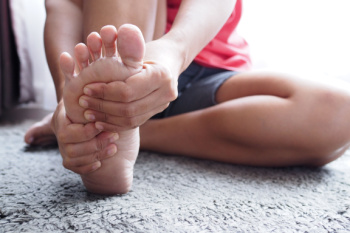Items filtered by date: July 2024
Key Strategies for Preventing Gout
 Gout, a painful form of arthritis that often affects the big toe, can be prevented through lifestyle and dietary changes. Maintaining a healthy weight also reduces the pain of gout by decreasing the stress on joints. Eating a balanced diet that limits purine-rich foods, such as red meat, shellfish, and sugary beverages, helps lower uric acid levels. Staying well-hydrated by drinking plenty of water aids in flushing out excess uric acid from the body. Regular physical activity not only supports weight management but also improves overall joint health. Limiting alcohol consumption, especially beer, can help prevent gout flare-ups. Additionally, managing medical conditions like hypertension and diabetes effectively reduces the risk. For those with a history of gout, regular check-ups and prescribed medications can help maintain lower uric acid levels. Gout in the big toe can cause severe pain and discomfort. If you are experiencing gout attacks, it is suggested that you are under the care of a podiatrist who can help you manage this condition.
Gout, a painful form of arthritis that often affects the big toe, can be prevented through lifestyle and dietary changes. Maintaining a healthy weight also reduces the pain of gout by decreasing the stress on joints. Eating a balanced diet that limits purine-rich foods, such as red meat, shellfish, and sugary beverages, helps lower uric acid levels. Staying well-hydrated by drinking plenty of water aids in flushing out excess uric acid from the body. Regular physical activity not only supports weight management but also improves overall joint health. Limiting alcohol consumption, especially beer, can help prevent gout flare-ups. Additionally, managing medical conditions like hypertension and diabetes effectively reduces the risk. For those with a history of gout, regular check-ups and prescribed medications can help maintain lower uric acid levels. Gout in the big toe can cause severe pain and discomfort. If you are experiencing gout attacks, it is suggested that you are under the care of a podiatrist who can help you manage this condition.
Gout is a foot condition that requires certain treatment and care. If you are seeking treatment, contact Steven Wolfington, DPM from Sheboygan Foot Care, LLC. Our podiatrist will treat your foot and ankle needs.
What Is Gout?
Gout is a type of arthritis caused by a buildup of uric acid in the bloodstream. It often develops in the foot, especially the big toe area, although it can manifest in other parts of the body as well. Gout can make walking and standing very painful and is especially common in diabetics and the obese.
People typically get gout because of a poor diet. Genetic predisposition is also a factor. The children of parents who have had gout frequently have a chance of developing it themselves.
Gout can easily be identified by redness and inflammation of the big toe and the surrounding areas of the foot. Other symptoms include extreme fatigue, joint pain, and running high fevers. Sometimes corticosteroid drugs can be prescribed to treat gout, but the best way to combat this disease is to get more exercise and eat a better diet.
If you have any questions please feel free to contact our office located in Sheboygan, WI . We offer the newest diagnostic and treatment technologies for all your foot and ankle needs.
How to Avoid Development of Blisters
 Preventing blisters is important for maintaining healthy feet. One way to avoid the development of blisters is by wearing well-fitted shoes that don't rub or cause friction against your skin. Additionally, it is suggested to change socks throughout the day, as wet or sweaty feet are more likely to blister. If you are aware of a spot that may become sore when engaging in daily activities that can cause friction, such as walking, or running, consider padding the inflamed area to reduce pressure. Applying cushioning pads where blisters commonly form can provide extra protection and reduce friction. Keeping up with foot hygiene can also decrease the risk of developing a blister on the foot. Keep your toenails trimmed and smooth to prevent them from catching on your socks or shoes, which can cause rubbing and blisters. If you notice any redness or hot spots on your feet, take immediate action to prevent blisters from forming. If you have a blister, especially if it is large, painful, or showing signs of infection, it is suggested to visit a podiatrist for safe treatment.
Preventing blisters is important for maintaining healthy feet. One way to avoid the development of blisters is by wearing well-fitted shoes that don't rub or cause friction against your skin. Additionally, it is suggested to change socks throughout the day, as wet or sweaty feet are more likely to blister. If you are aware of a spot that may become sore when engaging in daily activities that can cause friction, such as walking, or running, consider padding the inflamed area to reduce pressure. Applying cushioning pads where blisters commonly form can provide extra protection and reduce friction. Keeping up with foot hygiene can also decrease the risk of developing a blister on the foot. Keep your toenails trimmed and smooth to prevent them from catching on your socks or shoes, which can cause rubbing and blisters. If you notice any redness or hot spots on your feet, take immediate action to prevent blisters from forming. If you have a blister, especially if it is large, painful, or showing signs of infection, it is suggested to visit a podiatrist for safe treatment.
Blisters are prone to making everyday activities extremely uncomfortable. If your feet are hurting, contact Steven Wolfington, DPM of Sheboygan Foot Care, LLC. Our podiatrist can provide the care you need to keep you pain-free and on your feet.
Foot Blisters
Foot blisters develop as a result of constantly wearing tight or ill-fitting footwear. This happens due to the constant rubbing from the shoe, which can often lead to pain.
What Are Foot Blisters?
A foot blister is a small fluid-filled pocket that forms on the upper-most layer of the skin. Blisters are filled with clear fluid and can lead to blood drainage or pus if the area becomes infected.
How Do Blisters Form?
Blisters on the feet are often the result of constant friction of skin and material, usually by shoe rubbing. Walking in sandals, boots, or shoes that don’t fit properly for long periods of time can result in a blister. Having consistent foot moisture and humidity can easily lead to blister formation.
Prevention & Treatment
It is important to properly care for the affected area in order to prevent infection and ease the pain. Do not lance the blister and use a Band-Aid to provide pain relief. Also, be sure to keep your feet dry and wear proper fitting shoes. If you see blood or pus in a blister, seek assistance from a podiatrist.
If you have any questions, please feel free to contact our office located in Sheboygan, WI . We offer the newest diagnostic and treatment technologies for all your foot care needs.
Symptoms and Causes of Ankle Bursitis

Ankle bursitis occurs when the bursae sacs in the ankle become inflamed, causing significant discomfort and mobility issues. Bursae are small, fluid-filled sacs that act as cushions between bones, tendons, and muscles, reducing friction and facilitating smooth joint movement. These sacs can become irritated or inflamed, typically due to overuse, trauma, infection, or medical conditions like gout or rheumatoid arthritis. Common symptoms of ankle bursitis include pain and tenderness in the ankle, swelling, stiffness, warmth, or redness around the affected area. Aching or throbbing pain also can occur, especially when pressure is applied. Overuse from activities like running or dancing, trauma from injuries, or wearing poorly fitting shoes are frequent causes. Proper diagnosis may include imaging tests like X-rays or MRIs to rule out other conditions. In some cases, fluid from the bursae might be tested for infections. If you're experiencing symptoms of ankle bursitis, it is suggested that you make an appointment with a podiatrist for a diagnosis and treatment.
Ankle pain can be caused by a number of problems and may be potentially serious. If you have ankle pain, consult with Steven Wolfington, DPM from Sheboygan Foot Care, LLC. Our podiatrist will assess your condition and provide you with quality foot and ankle treatment.
Ankle pain is any condition that causes pain in the ankle. Due to the fact that the ankle consists of tendons, muscles, bones, and ligaments, ankle pain can come from a number of different conditions.
Causes
The most common causes of ankle pain include:
- Types of arthritis (rheumatoid, osteoarthritis, and gout)
- Ankle sprains
- Broken ankles
- Achilles tendonitis
- Achilles tendon rupture
- Stress fractures
- Bursitis
- Tarsal tunnel syndrome
- Plantar fasciitis
Symptoms
Symptoms of ankle injury vary based upon the condition. Pain may include general pain and discomfort, swelling, aching, redness, bruising, burning or stabbing sensations, and/or loss of sensation.
Diagnosis
Due to the wide variety of potential causes of ankle pain, podiatrists will utilize a number of different methods to properly diagnose ankle pain. This can include asking for personal and family medical histories and of any recent injuries. Further diagnosis may include sensation tests, a physical examination, and potentially x-rays or other imaging tests.
Treatment
Just as the range of causes varies widely, so do treatments. Some more common treatments are rest, ice packs, keeping pressure off the foot, orthotics and braces, medication for inflammation and pain, and surgery.
If you have any questions, please feel free to contact our office located in Sheboygan, WI . We offer the newest diagnostic and treatment technologies for all your foot care needs.
Various Reasons for Foot Pain

Sharp heel pain and general foot pain can result from several conditions. Plantar fasciitis, a common cause, is characterized by inflammation of the thick band of tissue running along the bottom of the foot. Bursitis, the inflammation of fluid-filled sacs that cushion the bones, can also lead to significant foot pain. Gout, a form of arthritis resulting from the accumulation of uric acid crystals, often causes sudden and intense discomfort in the big toe or ankle. Tarsal tunnel syndrome, involving compression of the tibial nerve, can create sharp, tingling pain extending into the arch. Additionally, heel spurs, which are bony growths on the underside of the heel, can cause stabbing pain, especially while walking or standing. If you have any type of foot pain, it is suggested that you consult a podiatrist who can determine the cause and offer treatment options.
Foot Pain
Foot pain can be extremely painful and debilitating. If you have a foot pain, consult with Steven Wolfington, DPM from Sheboygan Foot Care, LLC. Our podiatrist will assess your condition and provide you with quality foot and ankle treatment.
Causes
Foot pain is a very broad condition that could be caused by one or more ailments. The most common include:
- Bunions
- Hammertoes
- Plantar Fasciitis
- Bone Spurs
- Corns
- Tarsal Tunnel Syndrome
- Ingrown Toenails
- Arthritis (such as Gout, Rheumatoid, and Osteoarthritis)
- Flat Feet
- Injury (from stress fractures, broken toe, foot, ankle, Achilles tendon ruptures, and sprains)
- And more
Diagnosis
To figure out the cause of foot pain, podiatrists utilize several different methods. This can range from simple visual inspections and sensation tests to X-rays and MRI scans. Prior medical history, family medical history, and any recent physical traumatic events will all be taken into consideration for a proper diagnosis.
Treatment
Treatment depends upon the cause of the foot pain. Whether it is resting, staying off the foot, or having surgery; podiatrists have a number of treatment options available for foot pain.
If you have any questions, please feel free to contact our office located in Sheboygan, WI . We offer the newest diagnostic and treatment technologies for all your foot care needs.
It's Time for Beautiful Feet
Osteoarthritis and the Feet
 Osteoarthritis is a degenerative joint disease that commonly affects older adults, particularly in the feet and ankles. It occurs when the cartilage that cushions the joints breaks down, leading to pain, swelling, and reduced mobility. This condition is caused by the natural aging process, repetitive stress on the joints, or previous injuries. Individuals who are overweight, have a family history of arthritis or have jobs that place continuous stress on their feet are at greater risk. Diagnosis typically involves a physical examination, imaging tests like X-rays, and sometimes blood tests to rule out other conditions. Treatment focuses on managing symptoms and may include lifestyle changes, exercises, medications, or in severe cases, surgery. Maintaining a healthy weight, wearing supportive footwear, and engaging in low-impact exercises can help manage the condition. For specialized care and management, visiting a podiatrist is suggested.
Osteoarthritis is a degenerative joint disease that commonly affects older adults, particularly in the feet and ankles. It occurs when the cartilage that cushions the joints breaks down, leading to pain, swelling, and reduced mobility. This condition is caused by the natural aging process, repetitive stress on the joints, or previous injuries. Individuals who are overweight, have a family history of arthritis or have jobs that place continuous stress on their feet are at greater risk. Diagnosis typically involves a physical examination, imaging tests like X-rays, and sometimes blood tests to rule out other conditions. Treatment focuses on managing symptoms and may include lifestyle changes, exercises, medications, or in severe cases, surgery. Maintaining a healthy weight, wearing supportive footwear, and engaging in low-impact exercises can help manage the condition. For specialized care and management, visiting a podiatrist is suggested.
Arthritis can be a difficult condition to live with. If you are seeking treatment, contact Steven Wolfington, DPM from Sheboygan Foot Care, LLC. Our podiatrist can provide the care you need to keep you pain-free and on your feet.
Arthritic Foot Care
Arthritis is a term that is commonly used to describe joint pain. The condition itself can occur to anyone of any age, race, or gender, and there are over 100 types of it. Nevertheless, arthritis is more commonly found in women compared to men, and it is also more prevalent in those who are overweight. The causes of arthritis vary depending on which type of arthritis you have. Osteoarthritis for example, is often caused by injury, while rheumatoid arthritis is caused by a misdirected immune system.
Symptoms
- Swelling
- Pain
- Stiffness
- Decreased Range of Motion
Arthritic symptoms range in severity, and they may come and go. Some symptoms stay the same for several years but could potentially get worse with time. Severe cases of arthritis can prevent its sufferers from performing daily activities and make walking difficult.
Risk Factors
- Occupation – Occupations requiring repetitive knee movements have been linked to osteoarthritis
- Obesity – Excess weight can contribute to osteoarthritis development
- Infection – Microbial agents can infect the joints and trigger arthritis
- Joint Injuries – Damage to joints may lead to osteoarthritis
- Age – Risk increases with age
- Gender –Most types are more common in women
- Genetics – Arthritis can be hereditary
If you suspect your arthritis is affecting your feet, it is crucial that you see a podiatrist immediately. Your doctor will be able to address your specific case and help you decide which treatment method is best for you.
If you have any questions, please feel free to contact our office located in Sheboygan, WI . We offer the newest diagnostic and treatment technologies for all your foot care needs.

